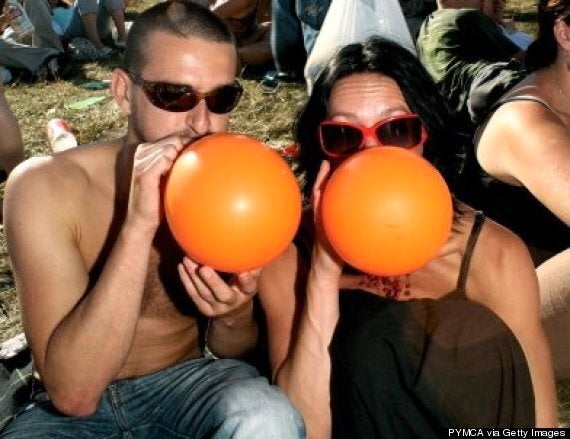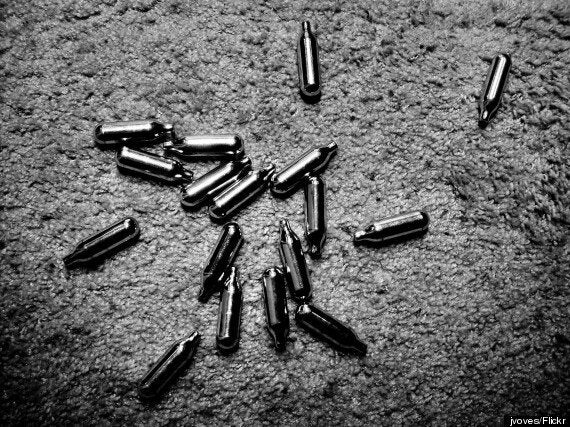More than 500,000 young people used laughing gas last year, which was the second most popular drug of 2013, prompting the government to release a warning of the dangers of the legal high - but was it really necessary?
Much has been made of the perceived dangers of nitrous oxide - to use its chemical name - from the Mirror's reporting of the "potentially lethal" substance to the Daily Mail's denunciation of the "deadly" high.
Police have issued warnings to students ahead of the new academic year about the dangers of laughing gas, stating there are views "far and wide that the drug can be highly dangerous".
A quick internet search brings up numerous articles on youths who have died after inhaling nitrous oxide, also known as NOs, many of whom are used as examples of victims of the "lethal" drug. However the dangers of the drug, which was more widely used than cocaine and ecstasy among young people in 2013/14, aren't as clear cut as has previously been claimed.
Joseph Benett, who is often used as proof of the dangers of laughing gas, actually died after inhaling a toxic cocktail of gases which he mistook for nitrous oxide. The 17-year-old student suffered a cardiac arrest after using an aerosol canister bought in Israel (called "smelly balloon") was actually a combination of butane, used in lighters, and pentane, used to make polystyrene.
Daniel Watts, whose "perplexing" death is also repeatedly used as evidence against the drug, was found next to a 5ft tall cylinder of the gas, along with a large plastic bag, a pillow and a pipe.

Nitrous oxide is freely available online
According to Harry Shapiro, director of information at DrugScope, the dangers of nitrous oxide are related to how it is consumed, rather than the effects of the drug.
"Some people will be inhaling it out of plastic bags and masks so you can restrict your air supply and asphyxiate from lack of oxygen," he told the Huffington Post UK.
Alistair Bohm of Addaction agrees, saying: "The risks from taking it from balloons are quite low. When there have been stories about deaths, they tend to be from people who are using canisters and masks, then you get into the dangers of asphyxiation.
"We can’t credibly deny that compared to other drugs it is relatively low risk."
The initiative comes in the wake of warnings from the Local Government Association after authorities seized massive hauls of laughing gas canisters - including 1,200 gathered in one night in Shoreditch, north London.
The LGA said it was "deeply disturbing" people widely view nitrous oxide as a safe legal high.
But DrugScience, formerly the Independent Scientific Committee on Drugs, lists the gas as "one of the least risky drugs", although does warn: "Breathing the pure gas directly from a tank using a mask on your face may be fatal because it can cause oxygen deprivation. Filling a bag with the gas from a tank and putting it over your head can kill easily."

A couple with orange laughing gas balloons, Ashton Court Festival, 2006
That's not to say there aren't any dangerous effects - but these are more aligned with the effects of too much alcohol, than a lethal drug.
"There certainly are risks, particularly to do with accidents that come from dissociative effects," Bohm explains. "We’ve heard stories about people getting into trouble if they’ve been driving after taking some, or falling into a river.
"There are long-term risks health authorities have talked about - Vitamin B12 depletion - which can lead to nerve damage. But it’s not the same kind of health risk that alcohol, heroin or a lot of new legal highs that are psychoactive substances."
Young users certainly don't seem to be fazed by the latest government warnings, as one 18-year-old student told HuffPost UK: "Well I have tried laughing gas a few times and I have never seen anyone have a bad reaction to it or seen anyone get addicted to it. And let's be honest it's all light-humoured fun. Personally I think if it is acceptable to drink alcohol then you should be able to do NOs. I definitely don't think it should be banned."
Demi Moore, another example wheeled out in the fight against laughing gas, had reportedly "smoked something" on the same night she was taken to hospital with convulsions.
But, as Bohm says, there is "always" a concern when drugs are mixed.
"As soon as you get into polydrug use, including alcohol, things get more dangerous. It’s always safest for someone to take laughing gas in a controlled environment."

Discarded laughing gas canisters
So why did the government include laughing gas in its campaign against legal highs?
At the time of the initiative's launch last month, crime prevention minister Norman Baker said: "All too often young people take their lives into their own hands by dabbling with so-called ‘legal’ highs when they don’t even know if they are safe, let alone legal.
"Some of these substances are proven to be more dangerous than illegal drugs..This summer’s campaign is part of a wide range of action taken to clamp down on so-called ‘legal’ highs, including banning more than 350 substances."
Earlier this year, Baker wrote to festival organisers asking them to adopt a no legal highs policy towards psychoactive substances, while a ban is already in place at V Festival - and has been for seven years.
"The sheer numbers of people who are taking it is a cause for concern," Bohm continues. "Clearly that’s to do with availability, cost and the perception of it being low risk."
Shapiro adds: "There’s no danger of it being cut or mixed with other substances - it’s not like an ordinary street drug - but there is an issue about the environment in which this is taken.
"People go to festivals and say it’s all over the place. There is a concern just because there is so much of it about at the moment.
"The more out of it you are the more chance you’re going to have an accident, especially if you’re doing laughing gas in an unusual or isolated place, rather than in a safe environment."
So it seems the dangers of this legal high are similar to those of another legal drug - alcohol; more related to the method of consumption and the environment in which this is taken, rather than the actual drug.
